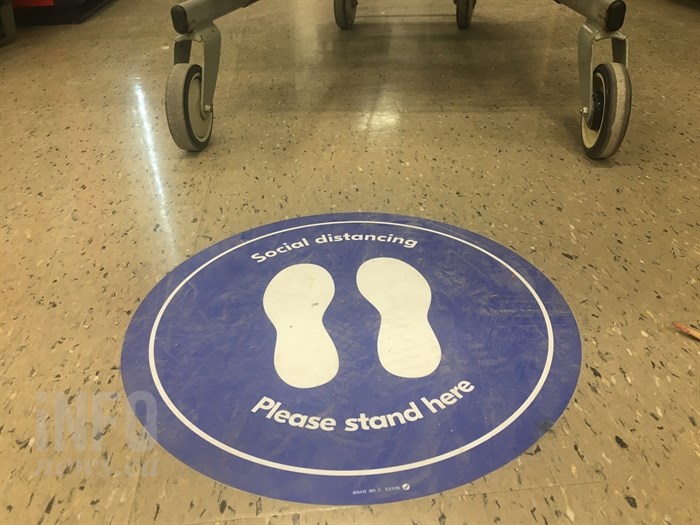
Even with vaccines being rolled out, people still have to follow COVID rules.
(BEN BULMER / iNFOnews.ca)
April 17, 2021 - 6:30 AM
So many B.C. residents are slacking off on their COVID prevention behaviors that the province might be heading for a crisis.
“All of us collectively need to reduce our infectious contacts,” Provincial Health Officer Dr. Bonnie Henry said Thursday, April 15, in a news briefing. “So that’s reducing those indoor contacts where we’re not using masks, where we have poor ventilation, where we’re not keeping our distance."
If B.C. residents keep socializing they way they have been for the past few weeks, the 1,200 per day pace of new cases could hit 3,000 by the end of May, according to a B.C. COVID-19 Modelling Group report.
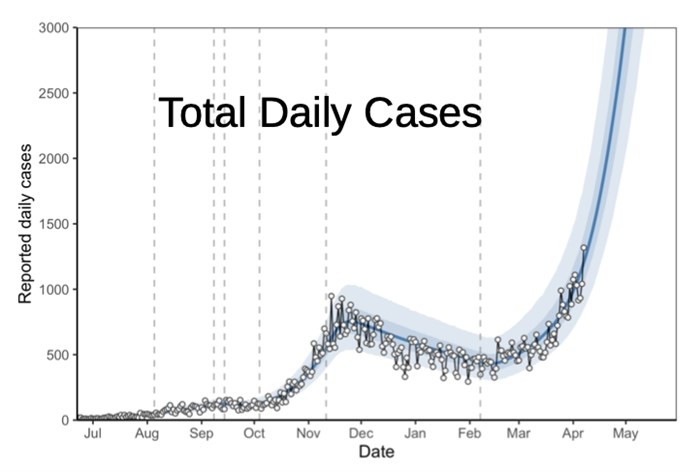
Image Credit: Submitted/B.C. Modelling Group
If that happens, B.C. could end up in a similar situation to what Ontario is facing right now. That province reported a record 4,812 new cases today, breaking yesterday’s record of 4,736.
It also issued a plea to the rest of Canada to send nurses and health care workers, estimating its hospitals will need more than 4,000 additional nurses over the next few months.
READ MORE: Ontario asks other provinces, territories to send nurses as COVID surges
B.C. faces the same staffing shortfall.
Health Minister Adrian Dix, at the same news briefing yesterday, listed off how many hospital beds are available and how many surge beds can be used.
Right now, for example, there are 339 vacant critical care beds in the province. Of the total of 780 such beds, 125 are currently occupied by COVID patients.
“We are not deficient in any way in our ventilator capacity or our bed capacity but when it does happen, when we move into surge beds, it puts significant additional pressure on staff,” Dix said.
Already, particularly in the Northern health region, patients had to be shipped to other hospitals far from their homes when COVID overwhelmed local facilities.
“That’s why we put in the restrictions that we put in, why we’re focusing on measures we need to do in the communities to prevent transmission to reduce the risk of people needing hospitalization,” Dr. Henry said.
At this time last year, thousands of non-emergency surgeries were postponed to free up space in hospitals. While it ended up not being needed at that time, treatments for people suffering from non-COVID ailments were delayed, sometimes for months.
Throughout the pandemic, health officials have been balancing the need to prevent deaths and overburdening hospitals with the disruptions to society required to minimize the spread of COVID.
Vaccines have helped lower the death rate, as seen in the graph below. The red line shows the death rate, blue the hospitalization rate and green the number of cases since the start of the pandemic.
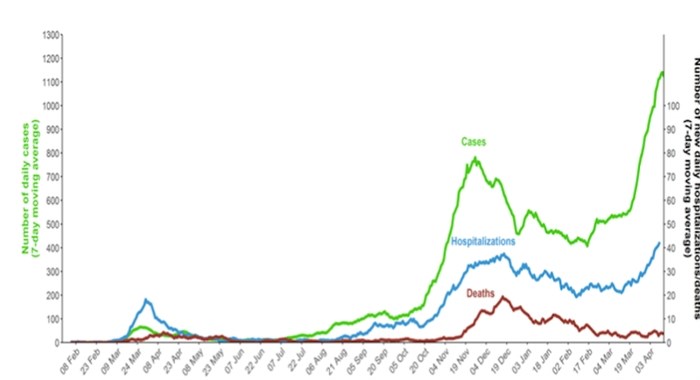
Image Credit: Submitted/B.C. Centre for Disease Control
Because older people tend to get sicker and die of COVID, they’ve been the first to receive vaccines so they are no longer dying at the same rate as last fall.
But, the growing number of cases brings with it increased hospitalizations of younger people – mostly those between the ages of 19 and 59.
The graph below shows the daily case counts by age, with the green line being those aged 19-39, the red line for those aged 40-59, the yellow line for ages 60-79, blue for ages five to 18, purple for ages 80 and over and the light blue at the bottom is children under four years of age.
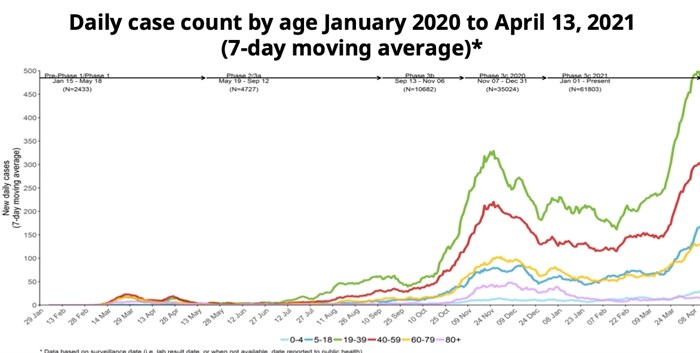
Image Credit: Submitted/B.C. Centre for Disease Control
The recent surge in case numbers is due to variants of concern that spread more easily when people let down their guards.
“Variants of concern grew exponentially in February and March, doubling every 8.6 days,” states a report by the B.C. COVID-19 Modelling Group.
It says the recent surge of cases has been “driven” by these variants and that transmission of the disease has to be reduced by 40 per cent to get it under control. If that doesn’t happen, daily case counts could rise to 3,000 by the end of May.
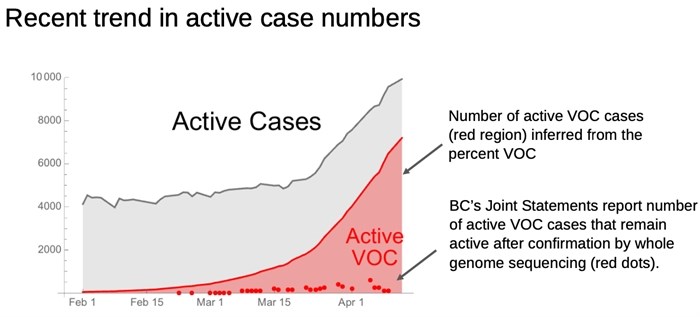
Image Credit: Submitted/B.C. Modelling Group
Dr. Henry has said repeatedly that, given the fact the variants transmit much more easily than regular COVID (dubbed “wild” COVID by the modelling group) that there is very little room for error.
“We have orders around indoor gatherings,” Dr. Henry said. “We have restrictions in workplaces. Those are having an effect but we cannot let up right now.”
People should not be travelling outside their communities and only have outdoor gatherings with the same small group of people. Masks still need to be worn outside if there’s going to be close contact with others, she said.
“Transmission must be reduced by about 40 per cent to control case growth (relative to March 2021 levels),” the modelling group report states.
See that full report here.
The latest information on the B.C. Centre for Disease Control's website can be seen here.
To contact a reporter for this story, email Rob Munro or call 250-808-0143 or email the editor. You can also submit photos, videos or news tips to the newsroom and be entered to win a monthly prize draw.
We welcome your comments and opinions on our stories but play nice. We won't censor or delete comments unless they contain off-topic statements or links, unnecessary vulgarity, false facts, spam or obviously fake profiles. If you have any concerns about what you see in comments, email the editor in the link above.
News from © iNFOnews, 2021